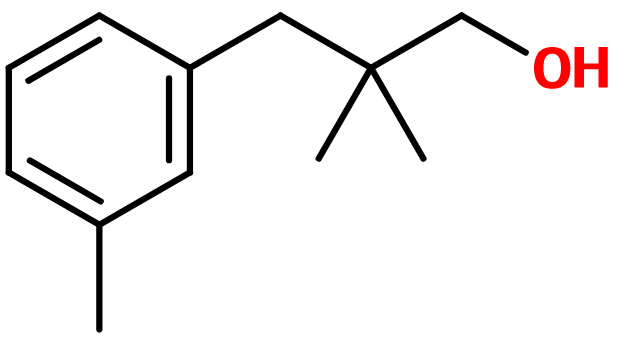Majantol®
Synthétique
Floral > Light Flowers > Aldehydic > Fresh Flowers > Aquatic

Crédits photo: ScenTree SAS
Other names :
2,2-dimethyl-3-(3-methylphenyl) propanol ; 2,2-dimethyl-3-(3-methylphenyl) propan-1-ol ; 3-(2,2-dimethyl-3-hydroxypropyl)toluol ; Lanjantol ; Lilivol ; Lily propanol ; Linlan alcohol ; Muguenol ; Trimethyl benzene propanol ; Trimethylbenzenepropanol
Volatility :
Heart
Uses in perfumery :
Majantol® enters the floral-aldehydic molecules category, including Lilial® and Bourgeonal® for example. It is used as it is slightly less regulated, for lily of the valley and other white flower notes, for a light effect, in association with other molecules as Hedione® or Florol®. It also brings a fresh nuance.
Natural availability :
Majantol® is not reported as found in nature, and can thus not be extracted from any plant.
Year of discovery :
Patent N°3,531,585 (DE) published on Sept. 4, 1985 by Elektrochemisch Industrie GmbH
Other comments :
Majantol® structure is close to Dimethyl Benzyl Carbinol. Its smell is less aldehydic and aqueous. Majantol® also has olfactive similarities with Lyal® and Hydroxycitronellal®, although it is more aqueous than theses molecules.
Price Range :
€€
Stability :
Aromatic compounds are chromophorous. This means that they may color through time and in contact with alkaline bases.

Crédits photo: ScenTree SAS
- Molecular formula :
- C12H18O
- Molecular Weight :
- 178,27 g/mol
- Density :
- 0,97
- Flash Point :
- 93°C
- Fusion Point :
- 24°C
- Appearance :
- Colorless liquid that solidifies at room temperature
- Log P :
- 3,38
- Boiling Point :
- 289°C
- Detection Threshold :
- Donnée indisponible.
Synthesis route :
Majantol® can be prepared in two steps, starting with 3-methylbenzyl chloride, reacting it with 2-methylpropanal, in the presence of a catalysor as tetrabutylammonium iodide. An aldehyde is obtained and can be reducted, reacting with sodium tetrahydruroborate, to obtain the final product.
Synthesis precursor :
Majantol® is not a precursor for the synthesis of another material used in perfumery.
Isomerism :
Majantol® has a methyl group associated to carbon n°3 of its aromatic cycle, on a meta position. Molecules having this groupment on an ortho or para position are not used in perfumery, although they are isomers of Majantol®
Phenoxanol® is a constitutional isomer of Majantol®, having a more rosy and green note.
- EINECS number :
- 403-140-4
- FEMA number :
- Donnée indisponible.
- JECFA number :
- Donnée indisponible.
- FLAVIS number :
- Donnée indisponible.
- Allergens :
- This ingredient does not contain any allergen.
- IFRA :
- This ingredient is restricted by IFRA
- Restriction type :
- RESTRICTION_SPECIFICATION
- Cause of restriction :
- DERMAL SENSITIZATION AND SYSTEMIC TOXICITY
- Amendment :
- 49
- Comments :
- 2,2-Dimethyl-3-(3-tolyl)propan-1-ol should only be used as a fragrance ingredient if traces of organochlorine compounds are restricted. Total Chlorine, which can be measured by Atomic Absorption Spectroscopy, must not exceed 25 ppm in the raw material.
- Quantitative limit on the use :
-
Cat.1 Cat.2 Cat.3 Cat.4 Cat.5A Cat.5B Cat.5C Cat.5D Cat.6 0,034 % 0,2 % 0,025 % 1,7 % 0,43 % 0,061 % 0,039 % 0,013 % 0,0025 % Cat.7A Cat.7B Cat.8 Cat.9 Cat.10A Cat.10B Cat.11A Cat.11B Cat.12 0,052 % 0,052 % 0,013 % 0,14 % 0,14 % 0,3 % 0,013 % 0,013 % 8,6 % - Restriction type :
- RESTRICTION QRA
- Cause of restriction :
- Amendment :
- 45
- Quantitative usage limits :
-
Cat.1 Cat.2 Cat.3 Cat.4 Cat.5 Cat.6 Cat.7 Cat.8 Cat.9 Cat.10 Cat.11 0,28 % 0,36 % 1,5 % 4,5 % 2,4 % 7,2 % 0,8 % 2 % 5 % 2,5 % Not Restricted
To learn more about IFRA's standards : https://ifrafragrance.org/safe-use/library
ScenTree is solely responsible for the information provided here.


